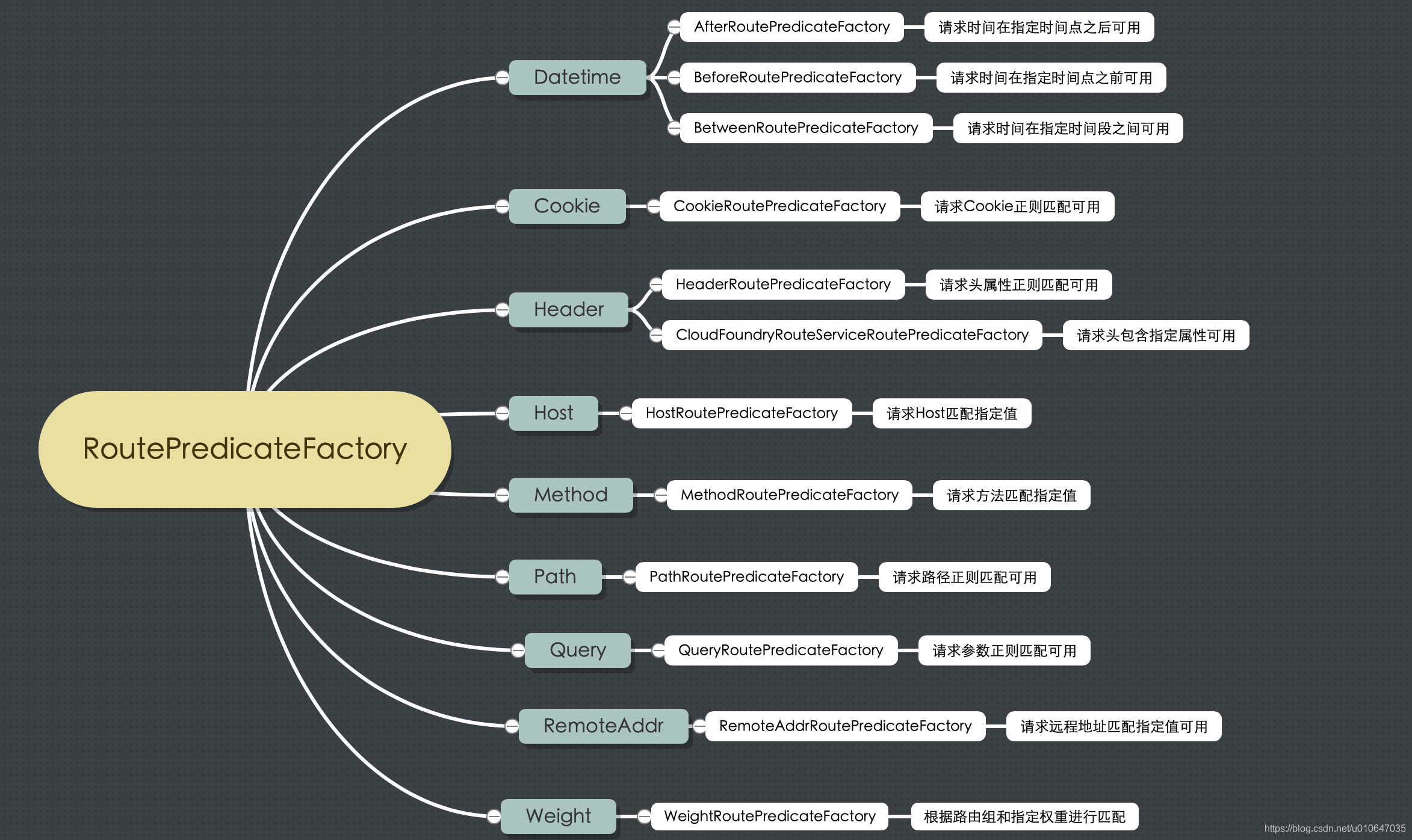本文基于 spring cloud gateway 2.0.1
1、简介
Spring Cloud Gateway 创建 Route 对象时, 使用 RoutePredicateFactory 创建 Predicate 对象,Predicate 对象可以赋值给 Route。 Spring Cloud Gateway 包含许多内置的Route Predicate Factories。所有这些谓词都匹配HTTP请求的不同属性。多种谓词工厂可以组合,并通过逻辑and。
路由选择是通过Predicate函数式接口进行判断当前路由是否满足给定条件。

路由谓词工厂 RoutePredicateFactory 包含的主要实现类如图所示,可以看到该接口有多个实现类。抽象类 AbstractRoutePredicateFactory 实现了路由谓词工厂,但是没有实际的方法,具体的实现类都是继承自抽象类 AbstractRoutePredicateFactory 包括 Datetime、 请求的远端地址、 路由权重、 请求头、 Host 地址、 请求方法、 请求路径 和 请求参数等类型的路由断言。
2、路由谓词工厂 RoutePredicateFactory
按照功能对路由谓词工厂进行划分,可以划分为以下几种,如图所示:

@FunctionalInterfacepublic interface RoutePredicateFactoryextends ShortcutConfigurable, Configurable { String PATTERN_KEY = "pattern"; // useful for javadsl default Predicate apply(Consumer consumer) { C config = newConfig(); consumer.accept(config); beforeApply(config); return apply(config); } default AsyncPredicate applyAsync(Consumer consumer) { C config = newConfig(); consumer.accept(config); beforeApply(config); return applyAsync(config); } default Class getConfigClass() { throw new UnsupportedOperationException("getConfigClass() not implemented"); } @Override default C newConfig() { throw new UnsupportedOperationException("newConfig() not implemented"); } default void beforeApply(C config) {} Predicate apply(C config); default AsyncPredicate applyAsync(C config) { return toAsyncPredicate(apply(config)); } default String name() { return NameUtils.normalizeRoutePredicateName(getClass()); }}
RoutePredicateFactory 接口继承自 ShortcutConfigurable 接口,ShortcutConfigurable 接口在多个实现类中都有出现,根据传入的具体 RouteDefinitionLocator 获取路由定义对象时,就用到了该接口中的默认方法。路由谓词的种类很多,不同的谓词需要的配置参数不一样,所以每种 路由谓词(断言)和过滤器的实现都会实现 ShortcutConfigurable 接口,来指定自身参数的个数和顺序。
2.1、ShortcutConfigurable
ShortcutConfigurable 接口提供的默认方法,主要用于对过滤器和断言参数进行标准化处理,将表达式和生成的键进行转换。
public interface ShortcutConfigurable { enum ShortcutType { DEFAULT { @Override public Map normalize(Map args, ShortcutConfigurable shortcutConf, SpelExpressionParser parser, BeanFactory beanFactory) { Map map = new HashMap<>(); int entryIdx = 0; for (Map.Entry entry : args.entrySet()) { String key = normalizeKey(entry.getKey(), entryIdx, shortcutConf, args); Object value = getValue(parser, beanFactory, entry.getValue()); map.put(key, value); entryIdx++; } return map; } }, GATHER_LIST { @Override public Map normalize(Map args, ShortcutConfigurable shortcutConf, SpelExpressionParser parser, BeanFactory beanFactory) { Map map = new HashMap<>(); // field order should be of size 1 List fieldOrder = shortcutConf.shortcutFieldOrder(); Assert.isTrue(fieldOrder != null && fieldOrder.size() == 1, "Shortcut Configuration Type GATHER_LIST must have shortcutFieldOrder of size 1"); String fieldName = fieldOrder.get(0); map.put(fieldName, args.values().stream() .map(value -> getValue(parser, beanFactory, value)) .collect(Collectors.toList())); return map; } }; public abstract Map normalize(Map args, ShortcutConfigurable shortcutConf, SpelExpressionParser parser, BeanFactory beanFactory); } static String normalizeKey(String key, int entryIdx, ShortcutConfigurable argHints, Map args) { /*************************(1)*********************************/ // RoutePredicateFactory has name hints and this has a fake key name // replace with the matching key hint if (key.startsWith(NameUtils.GENERATED_NAME_PREFIX) && !argHints.shortcutFieldOrder().isEmpty() && entryIdx < args.size() && entryIdx < argHints.shortcutFieldOrder().size()) { key = argHints.shortcutFieldOrder().get(entryIdx); } return key; } static Object getValue(SpelExpressionParser parser, BeanFactory beanFactory, String entryValue) { /*************************(2)*********************************/ Object value; String rawValue = entryValue; if (rawValue != null) { rawValue = rawValue.trim(); } if (rawValue != null && rawValue.startsWith("#{") && entryValue.endsWith("}")) { /*************************(3)*********************************/ // assume it's spel StandardEvaluationContext context = new StandardEvaluationContext(); context.setBeanResolver(new BeanFactoryResolver(beanFactory)); Expression expression = parser.parseExpression(entryValue, new TemplateParserContext()); value = expression.getValue(context); } else { value = entryValue; } return value; } default ShortcutType shortcutType() { return ShortcutType.DEFAULT; } /** * Returns hints about the number of args and the order for shortcut parsing. * @return */ default List shortcutFieldOrder() { /*************************(4)*********************************/ return Collections.emptyList(); } default String shortcutFieldPrefix() { return ""; }} 以上代码主要做了以下工作:
1)对键进行标准化处理,因为键有可能是自动生成,当键以_ genkey_ 开头时, 表明是自动生成的。
2)获取真实值,需要传入 Spring EL 解析器、Bean工厂等工具类。
3)对传入的 entryValue 是一个表达式的情况进行处理,这里默认是 Spring EL 表达式。
4)返回有关参数数量和解析顺序的提示。
3、Datetime 类型的路由谓词工厂
Datetime 类型的路由谓词工厂有三种,分别为:
-
AfterRoutePredicateFactory: 接收一个日期参数,判断请求日期是否晚于指定日志
-
BeforeRoutePredicateFactory: 接收一个日期参数,判断请求日期是否早于指定日志
-
BetweenRoutePredicateFactory: 接收两个日期参数,判断请求日期是否在指定时间段内
以 AfterRoutePredicateFactory 为例,介绍 Datetime 类型的断言工厂的应用:
spring: cloud: gateway: routes: - id: after_route_id uri: http://www.baidu.com predicates: - After= 2018-12-30T23:59:59.789+08:00[Asia/Shanghai]
上面的配置文件指定了路由的断言,谓词关键字是 After ,表示请求时间必须晚于上海时间 2018年12月30日 23:59:59 才可用。
4、基于远程地址(RemoteAttr)的路由谓词工厂
RemoteAddrRoutePredicateFactory 属于根据请求IP进行路由类型,接收 CIDR表示 法(IPv4或IPv6)的字符串列表(列表最小长度为1)作为参数, 例如 192.168.0.1/ 16, 其中 192. 168. 0. 1 是 IP 地址, 16 是 子 网 掩 码。
spring: cloud: gateway: routes: -id: remoteaddr_ route_id uri: http://www.baidu.com predicates: -RemoteAddr=192.168.1.1/24
以上配置表示如果请求的远程地址是 192.168.1.10,将会匹配该路由。
// RemoteAddrRoutePredicateFactory.java
@Override public Predicateapply(Config config) { List sources = convert(config.sources); return exchange -> { //获取请求中的远程地址 InetSocketAddress remoteAddress = config.remoteAddressResolver.resolve(exchange); if (remoteAddress != null) { String hostAddress = remoteAddress.getAddress().getHostAddress(); String host = exchange.getRequest().getURI().getHost(); if (log.isDebugEnabled() && !hostAddress.equals(host)) { log.debug("Remote addresses didn't match " + hostAddress + " != " + host); } //遍历配置好的 RemoteAddr 列表, 如果远程地址在列表中则匹配成功 for (IpSubnetFilterRule source : sources) { if (source.matches(remoteAddress)) { return true; } } } return false; }; } private void addSource(List sources, String source) { if (!source.contains("/")) { //当 RemoteAddr 没有子网掩码时,默认为/32 source = source + "/32"; } String[] ipAddressCidrPrefix = source.split("/",2); String ipAddress = ipAddressCidrPrefix[0]; int cidrPrefix = Integer.parseInt(ipAddressCidrPrefix[1]); //根据 ip 和 子网,确定 RemoteAddr 的范围,并加入到 sources 中 sources.add(new IpSubnetFilterRule(ipAddress, cidrPrefix, IpFilterRuleType.ACCEPT)); }
基于远程地址匹配的路由断言实现,首先获取配置文件中的 RemoteAttr 列表,然后将配置的 RemoteAttr 列表转换成 sources 列表,主要是根据IP地址和子网掩码确定地址范围,最后判断请求的远程地址是否在设置的 IP 列表中。